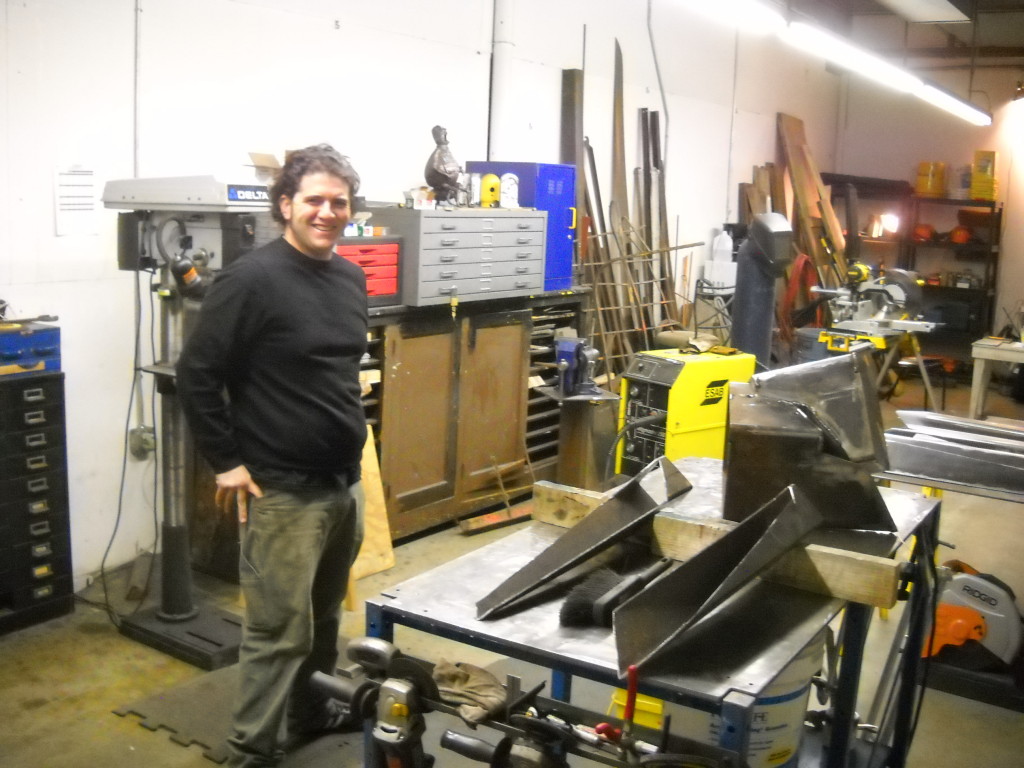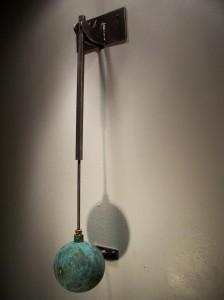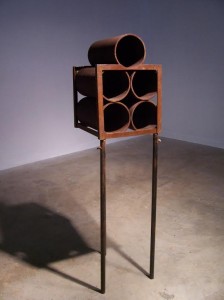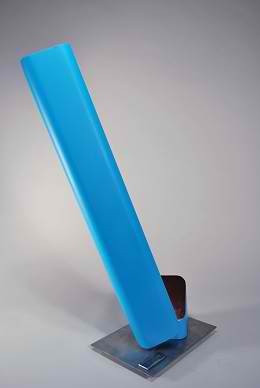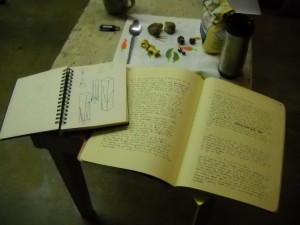See more of Bryan’s art at: Bryan Rasmussen
For interviews with other sculptors see: Turry Lindstrom / Maria Willison
As a sculptor, Bryan works primarily with steel and his studio, designed around the manipulation and fabrication of that metal, has an almost industrial feel. “I’m here most days, all day,” he says, “except for ‘relationship days’ that I spend with my fiancé, Christine. After my morning run I come in, put on some music, crank the volume up, and get to work.” Music is important to Bryan and his tastes are eclectic. He spent a few years after high school in the Chattanooga music scene where he played bass for several punk rock bands as well as being a photographer for various groups.
Growing up in the small north Georgia town of LaFayette, Bryan Rasmussen had one goal, and it wasn’t making sculpture—he didn’t want to work in a factory when he grew up. As a boy he was often drawing and his family, particularly his grandmother, encouraged him. In time he got a camera and became interested in photography. As his interest in that medium grew, he left his bass guitar behind and enrolled at the University of West Georgia as an art major with a specialization in photography. He was the first person in his family to go to college and get a degree and it was there, in the UWG art program that he discovered his artistic path.
“As part of the art program I had to take a sculpture class and I became very involved with the techniques for metal casting. The immediacy of the work appealed to me. In photography I could shoot two or three rolls of film photographing some object, then spend eight hours in the dark room and come away with a pounding headache from the chemicals and maybe a few prints I thought were really good. On top of that, it was the late 1990’s and photography was rapidly going digital. That, too, made it less appealing, since the digital process seemed almost surreal to me as an artist. On the other hand, with sculpture I would spend the day working and feel like I’d made some real progress, say building a mold or finishing a casting I’d done earlier. The physical labor was good; it gave me a sense of satisfaction. My hands would be dirty, maybe I’d have a cut, but there, at the end of the day, was the evidence that I’d done something. I found a reality in sculpture that was missing for me in photography.”
“I like to think of my work as objects of contemplation, that is, when placed in a space, they create a charged area for meditation and contemplation.”
With this early exposure to sculpture, he didn’t abandon photography immediately. Rather, he sought to incorporate a sculptural feel in his photographs and he began cutting up negatives and pasting them back together, forming what amounted to sculptural collages and making prints from the manipulated negative. Eventually a photography professor told him, “you’re not really doing photography any more, you’re trying to make sculpture with photography so why don’t you go do it for real?”
And Bryan did. He began studying with the sculpture professor at UWG, Kevin Shunn and it was an important formative experience. “He allowed his students to follow their ideas in a way that was unconstrained by his own preconceptions. Some teachers try to produce young versions of themselves but he didn’t. In addition, we were always free to explore the more conceptual aspects of sculpture and not just focus on object making. He was a great resource on technical matters, too. Mr. Shunn always seemed to have a lot of knowledge about any medium that you might want to work in.”
In 2005 Bryan received his BFA with a double concentration in photography and sculpture, but rather than go on to graduate school for an MFA, Bryan worked for next two years as a studio assistant to Carrollton, GA sculptor Gordon Chandler. In 2007 Bryan moved to Chattanooga, TN, where he was hired by the internationally recognized sculptor, John Henry (www.johnhenrysculptor.com), as a studio assistant. Bryan spent the next six years doing the hardest work of his life fabricating, delivering, and assembling John Henry’s designs on site.
“It was a really hard job—very intense and physically demanding. We worked in all weathers. Sometimes it was cold but the worst was when it was hot. Remember we don’t do anything to cool metal down, it’s the opposite, what we do, welding and all, just heats it up. You have to get used to burned hands and blisters. Then, after working for eight to ten hours it’s time to go to your studio and do your own work.”
Yet his time with John Henry was not without benefits for the young artist. “I’ll always keep what I learned about construction, engineering, and fabrication. Plus, I made contacts in the art world that would have taken me much longer any other way, and I really had a chance to learn the business side of the process.” A friend, the established sculptor Hank Lautz, advised him to learn everything he could in this area as it would be essential for his professional progress.
John Henry also helped Bryan by giving him a critique of his work. Bryan showed him several of his most recent pieces and John Henry, after looking the body of work over carefully, said that all of it was good, but each piece looked as if it had been made by a different artist. He saw no cohesiveness, no unity of vision. “I could see the links”, said Bryan, “but he couldn’t and it caused me to rethink my approach.”
“I stripped everything away and asked myself ‘what am I trying to convey through my sculpture?’ I want a sense of contrast and I want the feeling that something is being revealed, that something is coming apart.” His new work became more visually simple and direct. “I thought, what’s the simplest most direct thing there is? For me it’s the line, and to convey a line sculpturally I turned to square tubing. Then I made a cut and had the tube (or line) come apart to reveal the unseen. I added contrast using color both flat and glossy. Having the work stripped down to its very ‘seed’ allows it to grow in any direction and become more complicated and different.” But it is complication that is defined and controlled by the essence of his vision.
Bryan’s early sculpture was never painted. “I believed you needed to let the properties of the metal show and that you could get a sense of color through things like patina and rust, the natural oxidation of the metals.” Seeking additional textures he included such things as beeswax and cotton in his work.
With time and experience he changed his mind about the idea of paint and he now sees it as another tool, something to catch the eye and draw the viewer further into the work. “I don’t let paint overpower the piece—the form is important, indeed, the most important thing. That’s why I don’t put any text on my work, because I feel it then becomes about the text and the sculpture becomes just a sort of canvas. I want the form of the sculpture to be the most important thing.
- Silver Spoon– Steel
- Little Bird– Steel
- Bridge Walker– Steel
Bryan’s use of color is carefully measured to get the necessary visual impact with an economy of means that harmonizes with his elemental shapes. He uses complementary colors but seeks subtly in their use, for instance employing near complements such as a rusty orange with a powder blue. “Complementary colors, if they are balanced right and lit correctly, are going to vibrate and catch the eye.” In seeking interesting color harmonies, Bryan utilizes everything from a close observation of nature to seeking out the color combinations seen in fashion magazines. His metal working studio must be one of very few that has back issues of Vogue magazine lying around.
Bryan’s approach to developing all aspects of his art is a methodical one. He keeps carefully written journals of his thoughts on art and sketchbooks of future projects. “I like to write about things, collect ideas, and even gather natural things like seed pods or the vertebrae of small animals that can inform my thinking. It’s very important to the evolution of my work.”
That evolution now includes works in both large and small formats, though larger formats are a newer and less comfortable thing for him. In the past his use of such materials as beeswax and cotton precluded outdoor display. “I think of my work as objects of contemplation and for that they don’t have to be big. I find that sometimes with bigger pieces the size is more impressive than the concept. Of course you get more recognition because your large work is out in public, but smaller pieces can be more personal and immediate.”
In addition to his main focus on sculpture, Bryan also works with two-dimensional media drawing images, which he describes as being, “what my sculptures would be if they were drawings”. Yet even with these drawings, requiring as they do techniques so different from those he employs with his sculptures, he has an approach that rises out of his work with metal. After a base image is created he uses a sander with fine grain sandpaper to work over the surface of the drawing, thereby creating a subtly varied surface.
And as for the future?
“I’m working on making my shapes more complicated in order to give my work more interest. I guess you could call it enhancing the visual terrain. I want any piece I make to be the most interesting thing in the room. I’m always seeking to push to the next level.” And that search for the next level is an unending process for Bryan Rasmussen. As he says, “I am an artist. I don’t feel like I could truly be anything else. Nothing else would satisfy me. I’d rather do this than anything.”
Return to Interviews with Artists
